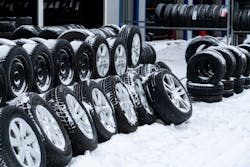For dealers in northern climates, the change in seasons brings a change in the weather that can significantly impact your business. By now, those dealers have already ordered winter tires or have identified the supplier that will keep them with ready stock of winter tires.
While this is part of the regular routine each year, it reminded me of a fundamental difference in business strategy that I often see. And that strategy comes down to two simple words: “on” or “for.”
Some dealers’ strategy is to plan on weather impacting their business, while others plan for weather impacting their business.
You will likely see this same comparison in other business plans when it comes to the effect of outside influences, but I am going to stay with weather and seasonality as our examples.
You might be thinking to yourself, “What’s the difference between planning on or planning for?”
Quite frankly, the difference can be profound. Those who plan “for” prepare for how things may be impacted. Those who plan “on” are dependent on the impact. These are two very different strategies and can mean the difference between controlling your circumstances or being a victim of them.
You may not have thought about it in these ways before, but I am sure you can relate to some of the examples I am about to share.
Throughout my career, I have heard dealers refer to their performance in a given month by stating, “We didn’t have the weather we had last year.” Depending on what last year was, that could be a good thing or a bad thing. However, regardless of the result, that statement indicates that the plan for that month was “on” weather impacting the business. It also indicates that the dealer was a victim of the weather, regardless of whether the weather was good or bad for business.
Please do not get me wrong. There is no question that weather changes and weather extremes play a part in our business. But as we all know, the weather is unpredictable, inconsistent and ever-changing. It is, quite simply, out of your control.
However, many dealers rely on the weather to drive their results. More than once, I have had a dealer say to me, “If we just would have gotten more snow, we would have had a solid month.”
So, as I am sarcastically prone to do, I replied, “Then why didn’t you make it snow?” I was likely to get either a chuckle or a burning stare with that remark, but it allowed me to make a point.
To be successful in any endeavor, I encourage people to focus on those things over which they have control and then make an impact in those things.
Too often, I see people dwell on things that they cannot control. When those things do not pan out the way they had hoped, they feel defeated, frustrated and even victimized.
We have absolutely no power or control over the weather. Period. So why do some dealers often lean on that as the reason for their results? They simply planned “on” the weather making a difference.
One thing we can control is how we plan and prepare for whatever Mother Nature decides to throw at us. Instead of relying on the weather to produce results, we need to decide what we will do if the weather is there and what we also will do if it is not.
Maybe our numbers were positively impacted by certain weather conditions that occurred during the previous year? Instead of hoping that you benefit from similar weather so you can exceed last year’s numbers, you need to plan for how you will get there if the weather “doesn’t cooperate.”
And that is the difference between planning “on” or planning “for.” When you plan “for,” you make the necessary preparations in case something should occur - in this case, weather events or conditions that are favorable to your business.
That might mean having a ready supply of winter tires in the most popular sizes. That could also mean increasing your overall stock levels of all-season tires in those sizes, as well.
Another example of planning “for” would be to have a protocol in place for employees in case the threat of weather causes an influx of customers coming in your door. This would likely mean “all hands on deck” during that time.
Another employee consideration is their safety if travel conditions deteriorate. You need a plan to address that possibility.
All of this comes down to planning for the conditions that may develop. That is what you can control. But it also includes plans detailing what you might need to do if the weather event or condition that you expect does not happen.
That is where a planning “for” strategy is far superior to a planning “on” strategy. You are developing a plan for what you will do if beneficial weather events or conditions do happen and what you will do if they do not happen.
As I mentioned earlier, severe weather can certainly impact business. But if you don’t plan for different scenarios, you are simply leaving your results to chance.
What are some things you can control? The first is ensuring that every vehicle entering your shop gets a thorough and complete tire inspection. This sounds simple, but too often it is not done as well as it could.
I once partnered with a business leader who was convinced that he could walk into any shop, with six or more bays that were full, and find an object in a tire that a technician had missed. Each time that I accompanied him, he would find a nail, a screw or a piece of glass. Sometimes these objects punctured all the way through the tire. Sometimes they were only in the tread area.
Regardless of the severity, what this showed is that tire inspections can become nothing more than a check-the-box exercise, if not performed properly. You owe it to your customers and your business to be flawless in the execution of this basic service.
One common reason why weather drives customers to replace their tires is that they finally realized how poor the tires’ performance has become while fighting the elements. Wouldn’t it be better to catch this issue before it becomes a bigger problem?
If we can provide information regarding their tires’ condition and the potential detrimental impact that poor tire conditions can have on performance, perhaps that customer will choose to be proactive and have those tires replaced?
Another thing you can control is your marketing. Are you reaching current or potential customers and encouraging them to have their tires inspected or replaced before problems occur? Are you using other forms of media to get your message out? Using the same old tactics will typically produce the same old results.
Look at new avenues, particularly ones that you can pull a lever quickly to launch. if needed. Social media posts and text blasts are examples of effective, quick-launch communication options.
Have you reached out to other businesses in your area? Look for small business fleets that you can service. This can be an exceptional way to supplement your regular retail customer base.
Plan time each week to visit businesses around you to see if there is an opportunity. I often suggest - just to show the possibilities - sitting by a major intersection near you and jotting down the name of any business vehicle that drives by. Look for logos. Record the business name and its telephone number, if you can. These are vehicles that are already in your area! Even if none of those companies are working with you now, you will develop a great prospecting list.
You need to take control of driving your results rather than hoping that Mother Nature will drive them for you. If she does, that’s wonderful. But if she doesn’t, you will have already put a plan in place that will get you to where you want to be.
You need to execute that plan and ensure your team is executing it, as well. The best part is that you have total control over this.
Again, the planning “on” versus planning “for” strategies will play out in any plans that you make for your business, not just seasonal ones.
Planning “on” being properly staffed versus planning “for” being properly staffed and planning “on” new equipment improving your shop’s productivity versus planning “for” new equipment to somehow boost your shop’s productivity are just a couple of examples.
Make sure you focus on what you can control. It is so much better to be in the driver's seat and in control of your direction than to be a victim of wherever the wind sends you.
Tire industry veteran Jeff Morgan is the executive director of Dealer Strategic Planning, the DSP Group. He can be reached at [email protected] or (651) 846-9871. For more, see www.20DSP.com.
About the Author

Jeff Morgan
Tire industry veteran Jeff Morgan is the executive director of TEN (Training and Education Network.) He can be reached at [email protected] or (651) 846-9871. For more, see www.mtdten.com
